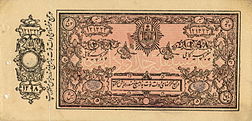 5 Afghan rupee banknote (1919) | |
| Unit | |
|---|---|
| Plural | rupees |
| Symbol | Re/Rs |
| Denominations | |
| Superunit | |
| 30 | habibi |
| 10 | tilla |
| Subunit | |
| 1⁄60 | paisa, paise (pl.) |
| 1⁄600 | dinar |
| Banknotes | Re. 1/-, Rs. 5/-, Rs. 10/-, Rs. 50/-, Rs. 100/- |
| Demographics | |
| Date of introduction | 1891 |
| Replaced | Kabuli rupee Kandahari rupee |
| Date of withdrawal | 1923[1] |
| Replaced by | Afghan afghani |
| User(s) | |
| This infobox shows the latest status before this currency was rendered obsolete. | |
The Afghan rupee was the currency of Afghanistan between the mid-18th century and early 20th century.[2][1] It was subdivided into 60 paisa, each of 10 dinar. Other denominations issued included the shahi of 5 paisa, the sanar of 10 paisa, the abbasi of 20 paisa, the qiran of 1⁄2 rupee and the tilla and later the amani, both of Rs. 10/-.
Before 1891, silver rupees circulated with copper falus and gold mohur. The three metals had no fixed exchange rate between them, with different regions issuing their own coins. That year, a new currency was introduced, based on the Kabuli rupee and replacing both that and its Kandahari variant. The Afghan rupee was replaced in 1923 by the Afghani.[1][3]
The Afghan rupee was put into circulation by Afghan Emperor Ahmad Shah Durrani in 1754.[2] The rupee itself was first issued by Sher Shah Suri during his rule of Sur Empire in the sixteenth century; India still uses its own variant of the rupee (along with Pakistan - see Pakistani rupee - since its creation in 1947).
- ^ a b c "Remembering King Amanullah Khan's Economic Reforms". TOLOnews. August 19, 2023. Retrieved 2023-08-31.
- ^ a b "Silver Rupee of Ahmed Shah Durrani". Mintage World. January 4, 2018. Retrieved 2023-08-31.
- ^ "بانکنوت های زمان امان الله خان" (in Persian).